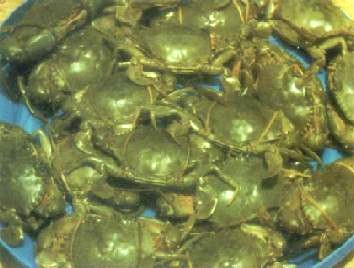|
17 October 2025
|
|
|
മലയാളം
|
|
|
|
|
|
Harvesting
The crabs are harvested after the shell becomes sufficiently hardened and before
next moulting. The harvesting is done by draining the pond and using scoop nets
and ring nets with baits. Harvesting should be done in the early morning hours or
evening to prevent mortality of crabs due to overheating of water at noon time.
In a year 9 to 10 cycles of fattening can be taken from a pond.
The harvesting of crabs can be effectively done in tide-fed ponds by letting in
water through the sluice into the pond during high tide. As the water flushes in,
the mud crabs tend to swim against the incoming water and congregate near the sluice
gate. They can be caught with the help of a scoop net and also by hand picking at
the lowest low tide levels. The expected survival rate would be 70 to 80%. The "water
crabs" encountered in the final harvest can be utilised for "fattening"
purpose.
Packing
The first pair of largest legs with pincers (chelate legs) of each crab should be
firmly tied up to the body by jute/nylon thread to avoid fighting among them. The
method of tying a live crab is as follows: a stick is firmly placed on the carapace
for instant arrest of its movement and the thread is placed in between the frontal
portion of the body and chelate legs. After keeping the chelate legs in folding
posture, the thread is coiled around their fingers (chelae) and both the ends of
thread are put into a double knot at the posterior end of the crab. Wet seaweeds
are kept in between the packed layers of crabs to enhance moist and cool condition
during transport from place to place. The tied-up crabs are washed with fresh seawater
and packed either in bamboo baskets or in perforated thermocole boxes for export
purposes.
|

Tied crabs
|

Packed crabs
|
Economics
Economics of three systems of mud crab farming
|
Culture Method
|
Monoculture
|
Polyculture
|
Fattening
|
|
Species
|
Scylla tranquebarica Scylla serrata
|
S. tranquebarica, Scylla serrata, Chanos chanos
|
S. tranquebarica Scylla serrata
|
|
Culture period (days)
|
120
|
138
|
30
|
|
Expenditure (Rs) (Seed, feed, pond preparation, labour)
|
43,860
|
48,400
|
56,200
|
|
Production (tonnes)
|
0.78
|
1.14 and 0.7 tonnes of milkfish
|
0.56
|
|
Income (Rs)
|
1,57,200
|
2,61,200
|
1,22,850
|
|
Net profit/ crop (Rs)
|
1,13,340
|
2,12,800
|
66,650
|
(Source: Indian Council of Agricultural Research, 2000)
Top
|
|
|
|
|
|